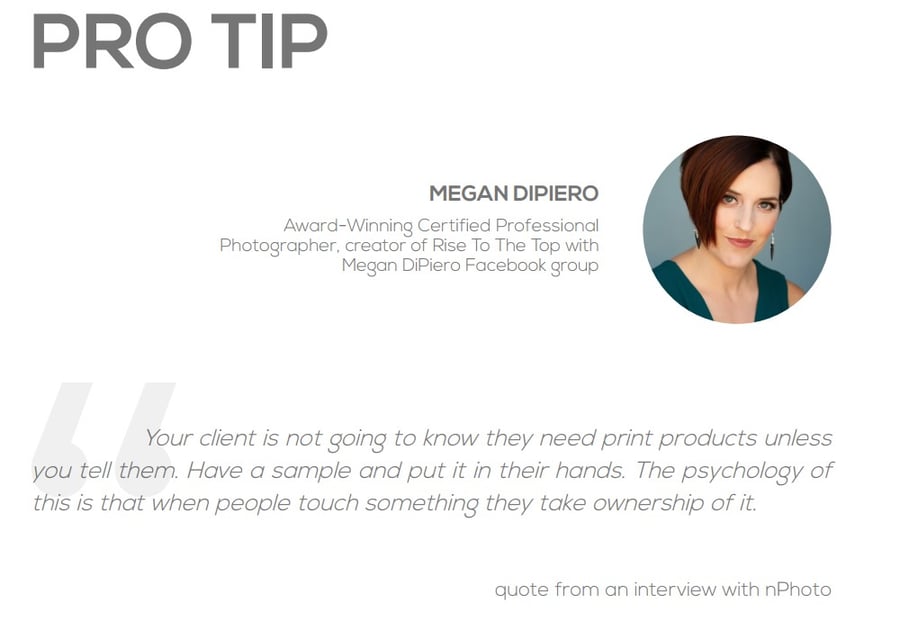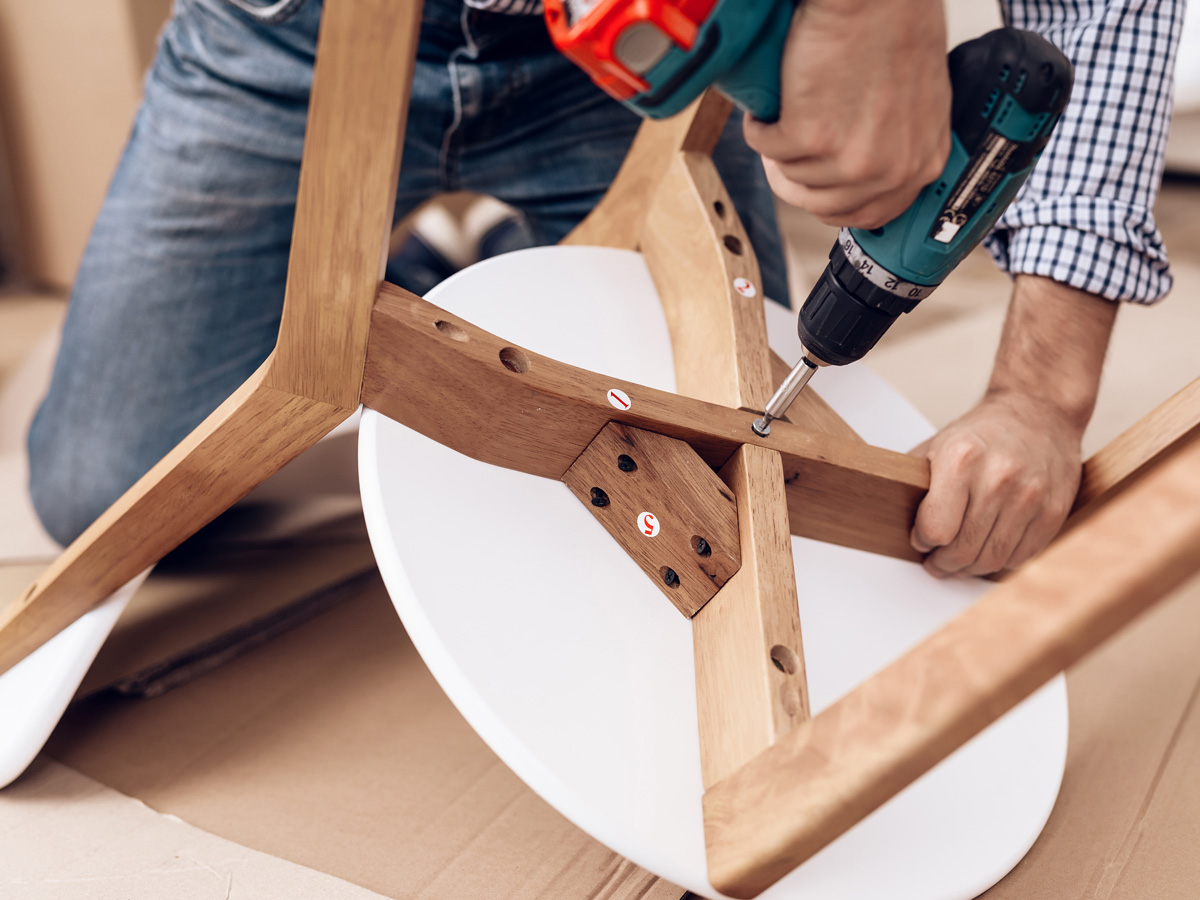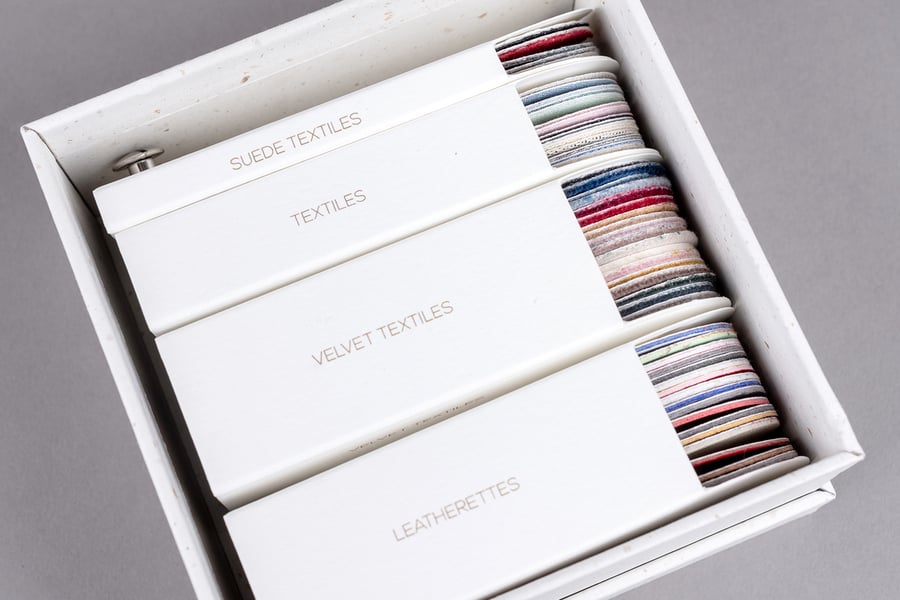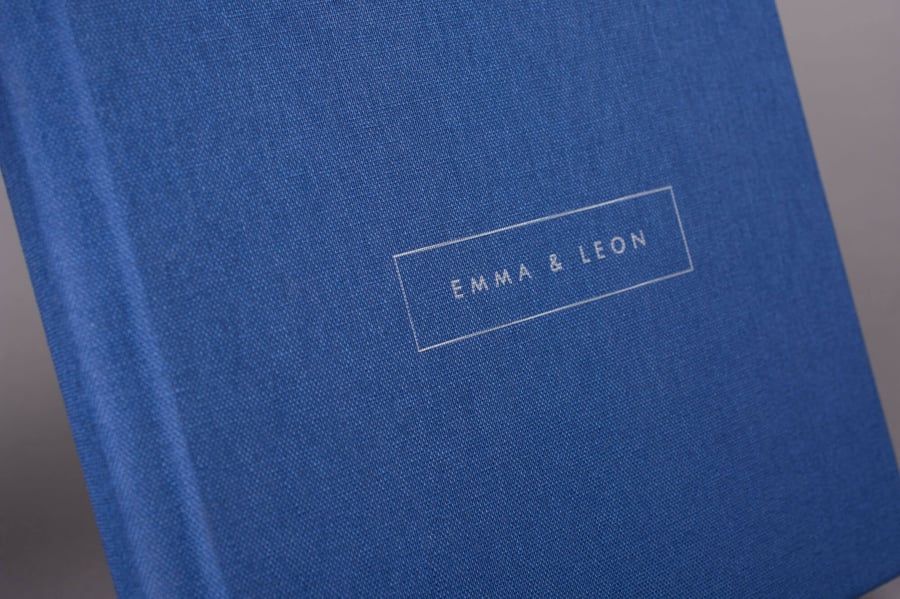Just what are we getting at? It’s quite obvious that we’d want you to order more print products, with us being a photo lab and what have you. But we’ve made this here post to show you, using actual research, why this is a mutually beneficial endeavor - we get more orders, you get more valuable sales, your client gets something they can admire for a lifetime; everyone wins.
If you’ve followed our photographer interviews or live chats (don’t worry, you won’t need to for the sake of this post) you may have noticed a few terms and ideas being shared, which resurface as a subject of discussion from time to time. We’ll be exploring one of these ideas today - the matter of clients holding print products in higher regard when they get close to them, or their creation process, to be more precise. We’ll also show you why this is related to the products you offer, and why both of these things can help you grow your photography business in the long run.

Excerpt from our wedding sample guide.
So, what else is there to extrapolate from the idea mentioned in the image above? Quite a lot, in fact. This phenomenon isn’t anything exclusive to albums (or exclusive collection Photo Albums for that matter), and it’s actually very similar in concept to something that was first observed by product designers in the mid-20th century, and later thoroughly researched through studies in consumer psychology. Today, this idea is more commonly known as the IKEA effect.

What is it?
At its core, the IKEA effect indicates that consumers will have a tendency to inflate the value estimation of something, which they have at least partially worked to create by themselves. The name is derived from the effective sales strategy of the IKEA brand, where said quirk could be easily observed from consumers putting together pieces of furniture and valuing their handiwork higher than similarly priced pre-made alternatives.
What’s important to highlight however, is that the observation itself does not originate from IKEA. Product designers somewhat understood this concept for quite some time, even before it became a topic deemed worthy of further research. Its earlier iteration was observed through cake mixes in the 1950’s consumer market.
In addition, multiple related studies were done to show the extent to which this aspect of human psychology could be applied, and their results showed that its effects spanned far beyond the application of consumer goods. A key aspect of making this strategy more successful was found, that being an innate simplicity to the task that is to be presented to the consumer. IKEA doesn’t ask its customers to carefully prepare the raw wood required for their goods, they merely allow them to put the prefabs together according to an easy-to-follow user manual.
The result of the IKEA study in particular, when quantified, is staggering - customers are willing to pay over 60% more for a product they had a hand in creating themselves, when compared to a pre-assembled equivalent of the same thing.

Why is this relevant?
As mentioned earlier, the results of these studies are not limited to consumer grade goods alone. Functionally, there is no reason why such findings couldn’t be applied to the design and creation of print products - which will become increasingly evident to you, should you decide to research this topic further on your own.
The fact that multiple photographers in our live chats, interviews, group discussions and even in some of the local workshops we’ve organized in the past have more or less voiced a similar version of the same general idea, is an even stronger indication that the IKEA effect is alive & well in the world of professional photography. And you should take advantage of this right now.
If even a part of the results derived from the IKEA study could be applied to your sales, we’re still talking about a considerable increase in your package pricing - that’s not something to scoff at. Think of all the extra income you could then invest back into your business, or the quality over quantity approach you could then take when scheduling meetings with your potential clients. And all that it takes is the right approach.
So… how is this achievable?
While as a photo lab, we may have a considerable amount of market data showing what previously worked for some photographers and what hasn’t, we’re still not omniscient - at the end of the day, no one is. What already worked out for one photographer may not necessarily work for another. Nevertheless, there are a few pointers which consistently showed a greater odds of helping photographers achieve success, regardless of any subjective differences surrounding them. We’ll cover a few of those pointers, specifically relevant to the IKEA effect below.
Using the IKEA effect to your advantage
Expand your print options. The more unique, customisable products you’ll have available as a part of your offer, the more of an educated buying decision your client will be able to make. This will allow your client to feel that it is truly their product, their thought-out choice. Yes, consumers tend to heavily sway toward emotion when making a buying decision, but this will only give you more breathing room to convey the kinds of details your clients will often attach themselves to - the feel of a product, the mood that a certain material or cover design creates, and so on.

While initially this may seem counterintuitive to the ethos of keeping things simple so as to avoid confusing your client (or worse, making them indecisive), you’re not actually creating that much of a knowledge barrier in practice. A real-life example would be having the option of ordering a Photobook Pro in place of a Photo Album if your client so desires. Both of these products are made in a way that is as unobtrusive to your sales process as possible - they offer the same cover collections, complete set options, packaging variety, etc. The main differences being that Photo Books are designed page by page, are not lay-flat and feature different paper options to the Photo Album.
Thus, your most important task would be to validate your client’s feelings; tell them of the product they are interested in and why it would be perfect for their personal needs. This is an area in which your lead generation strategies and emails could help, by adding in small ways to get to know your client a little better before the main sales meeting.

As the aforementioned studies claim, it’s more about creating the right balance of simplicity and choice, not minimizing one to favor another. After all, how can your client know if they’d prefer a different product if they’ve never even heard of it before? However, this is where choosing what you are most comfortable with should always be the best option. At the end of the day, it’s difficult to sell something you yourself are unsure about.
Hence, we often run limited-time sample offers for those looking to expand their product lineup - if you think what we’ve covered so far will assist you in any way, you’ll appreciate the opportunity to get a discount on print product samples. This allows you to get more acquainted with some of the options available and gives you the possibility of showing your clients the product in-person - which all leads back to the excerpt we’ve shown you near the beginning.
Allow your client to get involved with the design process. The degree to which you’ll do this is entirely up to you. The point is that, in theory, your client will become more invested in the print product you’re going to order for them, if they feel that they’ve had a hand in the creation process of the product - which material type to choose, what cover best matches their needs, why this paper option and not the other. These are all things which don’t affect the actual project designing part of your work in any real way, and your clients will have their own, fully personalized experience - all thanks to your careful guidance.
Through this kind of guidance, in their eyes you’ll not only be a professional service provider, but also an educator and an expert in your field - you’re free to let them know which options you’ve found to be your personal favorites and why. Lastly, should you suspect that this kind of approach will lead to some indecision, you can always subtly nudge the client towards options that you think are sure to result in a classy end product, through the careful use of upsells, price margins and preset collections.
Let’s say that you’re now at the end point of an initial meeting; you’ve talked things out, your client chose the print package that they found most appealing, and the photo session is as good as scheduled. If you inquire about it, and they say that they wouldn’t mind having something written down on the front cover of their product, this is the moment where you can tell them - that they should think about what text they’d like to see on that cover. It’s a seemingly small thing that you can give them until after the photo session is done to figure out.

This will likely lead to them giving it some thought, slowly growing that seed and letting them picture the end result in their mind before you even proceed to the photo shoot. In other words, you’ve effectively introduced them to the creative process before you even sat down to decide on the main features of the product. In their mind, that album is already theirs.
This uses an aspect of human psychology where we tend to focus on things that were already stated to us, as opposed to thinking outside the box - the thought of the print product being a part of the outcome from your photo session outweighs the contrary, further reinforcing the sense of value you’re creating for the product. Once the discussion turns to pricing, this sheer projected value will have a far better chance of defending itself without any further input.
With all of that said, the key parts to summarize from the above are:
- Your clients will see a bigger value proposition if they are allowed to customize their print options.
- Having more options doesn’t have to result in more confusion.
- Letting your client picture the ownership of a print product will further increase its value.
…And the best for last: use samples to show what you sell. None of the above will have the same effect if your client can’t visualize what they can get.
Keeping those things in mind will allow you to raise your package pricing by a considerable amount - and your business will flourish as a result.
Remember to check out our latest limited time sample offer to expand your package lineups - and start offering in style.